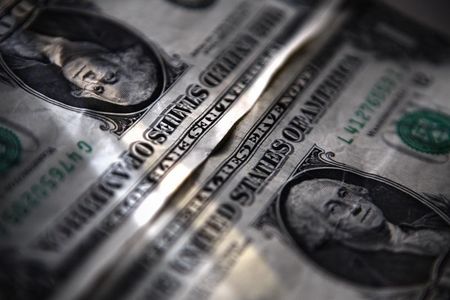Forex
Dollar retreats ahead of election; Fed, BOE also in spotlight

Investing.com – The U.S. dollar retreated Monday amid political uncertainty ahead of Tuesday’s presidential election and with the Federal Reserve expected to cut interest rates later in the week.
At 04:10 ET (09:10 GMT), the Dollar Index, which tracks the greenback against a basket of six other currencies, fell 0.5% to 103.695, after strong gains in October.
Dollar slips ahead of US election
The focus at the start of this week turns to the all-important US presidential election on Tuesday, with the race between Republican Party candidate Donald Trump and Democratic rival Kamala Harris extremely close.
That said, Harris received a particular boost when a respected survey out of the traditionally conservative-leaning state of Iowa showed her leading Trump by three percentage points, due in large part to support among women.
“Markets are seemingly scaling back some Trump trades,” said analysts at ING, in a note, “and we suspect the next two days can see some abnormal swings in USD crosses due to tighter volatility conditions ahead of a closely contested and highly binary US election.”
Analysts believe Trump’s policies on immigration, tax cuts and tariffs would put upward pressure on inflation, bond yields and the dollar.
Additionally, markets were also positioning for a 25 basis point cut by the at the conclusion of its latest two-day policy meeting on Thursday, following the central bank’s decision to roll out a jumbo 50-basis point reduction in September.
Friday’s showed a dramatic slowdown in jobs created in October, but the release was impacted by hurricanes and labour disputes.
“Had it not been for the proximity of the vote, we would have argued a Fed cut would have been net-negative for the dollar, but the implications for FX of this Fed decision will only be assessed once the election volatility has dimmed down,” ING added.
Euro gains on eurozone data improvement
In Europe, traded 0.5% higher at 1.0892, with the pair helped by dollar weakness as well as relatively positive recent data.
The final release saw an increase to 46.0 in October, an improvement from 45.0 the prior month, data showed earlier Monday. While this shows the sector was still in contraction territory, there appears to be some brightness emerging on the horizon.
“Markets have scaled back some European Central Bank dovish bets after the latest eurozone growth and inflation numbers, but probably remain open to pricing back in the chance of a 50bp December cut should Trump win this week,” ING added. “The rationale there is that the ECB will be more inclined to frontload easing given the risk of protectionism under Trump.”
rose 0.3% to 1.2963, bouncing from last week’s losses in the wake of the new Labour government’s budget.
The also meets Thursday and is expected to cut by 25 basis points, although this decision has been complicated by a sell-off in gilts following the budget last week.
“Markets will probably be more interested in hearing what the MPC has to say about last week’s budget,” ING said, given the “Office for Budget Responsibility sees the announced fiscal measures are both pro-growth and inflationary.”
Yen rebounds from three-month lows
fell 0.6% to 152.11, retreating from recent three-month highs on the back of dollar weakness. The yen also benefited from a somewhat hawkish message from the last week.
dropped 0.3% to 7.1009, with focus turning squarely to a meeting of the Standing Committee of the NPC that begins from Monday.
The NPC is widely expected to outline plans for more fiscal spending, with recent reports suggesting the body could approve $1.4 trillion in additional debt over the coming years.

 Forex3 years ago
Forex3 years agoForex Today: the dollar is gaining strength amid gloomy sentiment at the start of the Fed’s week

 Forex3 years ago
Forex3 years agoUnbiased review of Pocket Option broker

 Forex3 years ago
Forex3 years agoDollar to pound sterling exchange rate today: Pound plummeted to its lowest since 1985

 Forex3 years ago
Forex3 years agoHow is the Australian dollar doing today?

 Cryptocurrency3 years ago
Cryptocurrency3 years agoWhat happened in the crypto market – current events today

 World3 years ago
World3 years agoWhy are modern video games an art form?

 Commodities3 years ago
Commodities3 years agoCopper continues to fall in price on expectations of lower demand in China

 Economy3 years ago
Economy3 years agoCrude oil tankers double in price due to EU anti-Russian sanctions





















